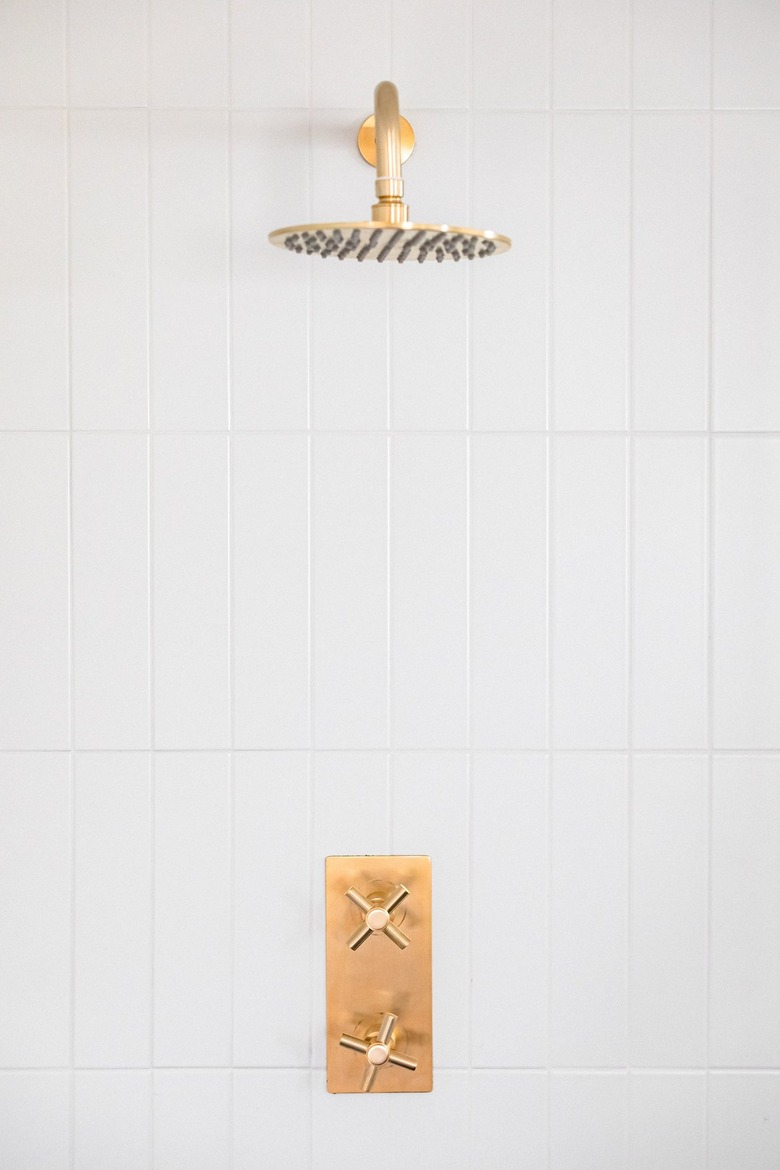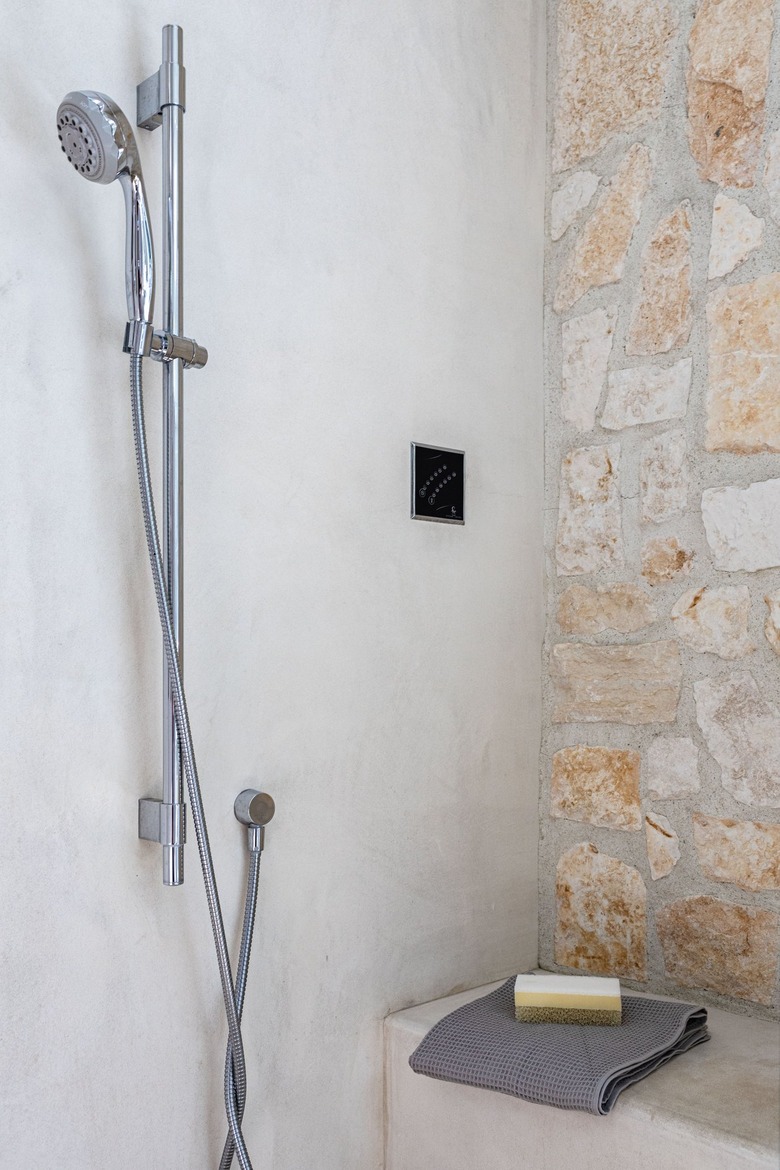How To Remove And Replace A Showerhead
We may receive a commission on purchases made from links.
It may be time for a new showerhead if the current one is falling apart, shows signs of wear and damage or simply no longer meets your preferences for the ideal shower spray. Some new showerhead models also use less water while still providing a powerful spray, which ultimately saves you money on water bills without settling for wimpy water pressure. No matter why you want to replace the old showerhead, there is no need to call a plumber to do the job. In most cases, it is a simple DIY home improvement task.
Before Removing the Old Showerhead
Before Removing the Old Showerhead
Although removing a showerhead is as simple as unscrewing it from the protruding shower pipe, it is not always easy. Trying too hard without securing the protruding pipe, also called a shower arm, could result in loosening the shower arm or damaging the showerhead.
The other end of the shower arm, which is hidden in the wall, threads into a pipe elbow, which connects to the vertical pipe that brings water up from the shower valve (the faucet). If you accidentally loosen the shower arm as you remove the showerhead, it could cause a leak inside the wall if you fail to tighten the shower arm before replacing the showerhead. The best way to remove the old showerhead is to try the easiest methods first and then break out the tools if you can't loosen it by hand.
Removing the Old Showerhead
Removing the Old Showerhead
In some cases, the showerhead can be removed by hand without tools or excessive force. Gently turn the showerhead counterclockwise and see if it budges. If not, grip the shower arm with one hand to ensure it doesn't loosen and then turn the showerhead counterclockwise again. According to Water Pik, some showerheads have a connecting nut at the base. If you see a large nut where the showerhead connects to the shower arm, turn the nut counterclockwise rather than the showerhead itself.
For a showerhead that is too tight to remove by hand, place a towel around the shower arm (to protect its finish from scratches) and then grab it with tongue-and-groove pliers (often called Channellock after the popular brand name). With the other hand, grab the showerhead base or connecting nut with another pair of pliers and turn counterclockwise. Once again, take care not to use excessive force, as this will help prevent broken showerhead parts or a loosened shower arm.
Sometimes, mineral buildup causes the connection between the showerhead and shower arm to seize up, but household white vinegar comes in handy for dissolving that buildup. Fold a paper towel into a strip about 2 inches wide, saturate it with vinegar and then wrap the paper towel around the connection point. Squeeze the towel a bit so some vinegar gets into the threaded areas between the showerhead and shower arm.
If the showerhead still does not wiggle free after 20 minutes or so, pour some vinegar into a plastic zippered bag, place the bag over the showerhead so the vinegar covers the connection between the showerhead and shower arm and then secure the bag with rubber bands or twist ties. Wait 45 minutes or longer and then remove the bag and try removing the showerhead once again.
Clean the Connection
Clean the Connection
Even if the showerhead came off easily, there may be some gunk and mineral buildup on and in the exposed end of the shower arm. Wipe the inside and outside of the pipe with a rag to clear off any residue you see. If the residue looks chalky like mineral deposits, soak part of the rag in vinegar and let the rag sit atop the area for at least 15 minutes before wiping it away. For severe deposits, you may have to do this several times.
A toothpick or bent paper clip comes in handy for removing bits of old plumbers' tape stuck to the threads of the shower arm. Removing all such debris is necessary in order to ensure a leak-free showerhead installation.
Attaching the New Showerhead
Attaching the New Showerhead
Although the installation process is similar for most showerheads, it is not always the same. Read any paperwork that came with your new showerhead to see if installation requires plumbers' tape, which is sometimes called Teflon tape, PTFE water-sealant tape or thread-seal tape. Some plastic showerheads in particular are not meant to have plumbers' tape used for installation. Other showerheads, such as some Water Pik models, also have a rubber washer that must be installed inside the showerhead assembly. If so, push the washer as far as it will go inside the showerhead so it sits flat.
- Wrap the threaded portion of the shower arm three to five times in a clockwise direction with 1/2-inch plumbers' tape, limiting the taped area to the threads. Applying it clockwise is a must, or it could unravel or come apart as you attach the showerhead, causing leaks.
- Trim the excess tape and smooth down the tape over the shower arm threads. The tape should be tight and secure atop the threads.
- Attach the showerhead by turning it clockwise onto the taped shower arm threads. Hand tighten it but don't overtighten, as this could cause leaks.
- Turn on the shower, using care not to get yourself or the area outside of the shower wet. Inspect the connection point between the showerhead and the shower arm for leaks. If there are none and you can turn the shower on at full power without any leaks, your job is complete. If it leaks a bit, tighten the showerhead or its connecting nut using a towel and two pairs of pliers as when loosening the old head. Tighten no more than 1/4 turn at a time.
- Test the shower for leaks after each adjustment until it no longer leaks.

